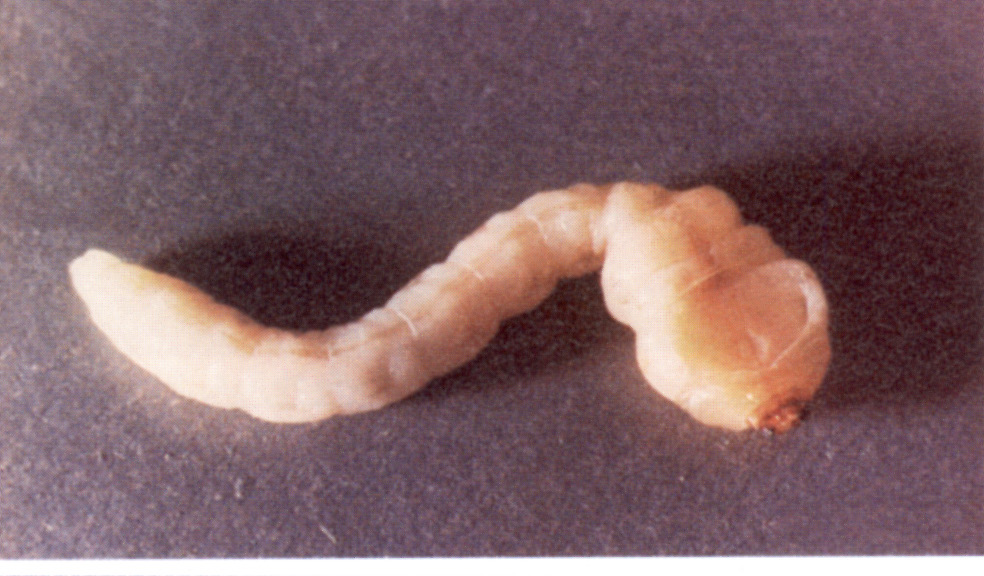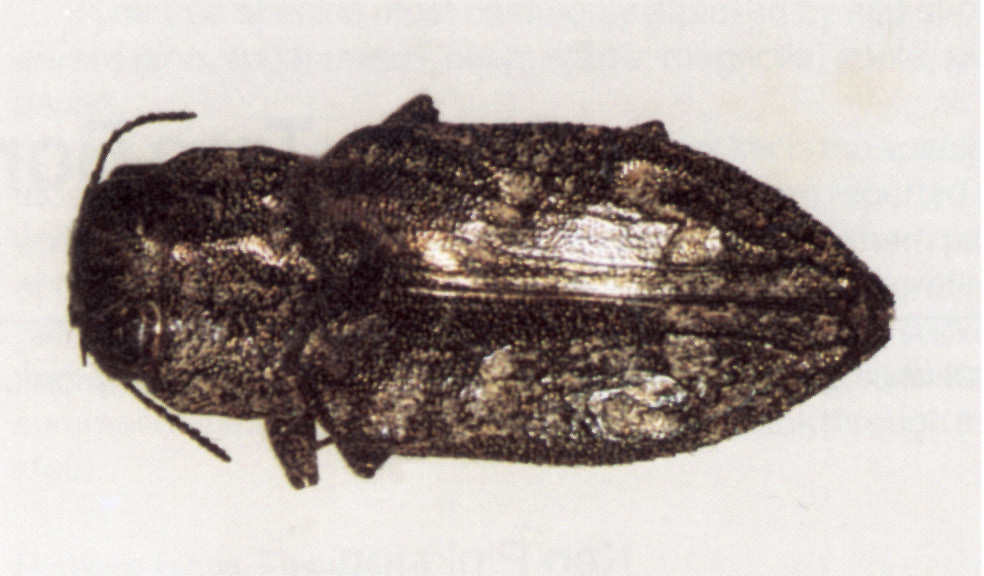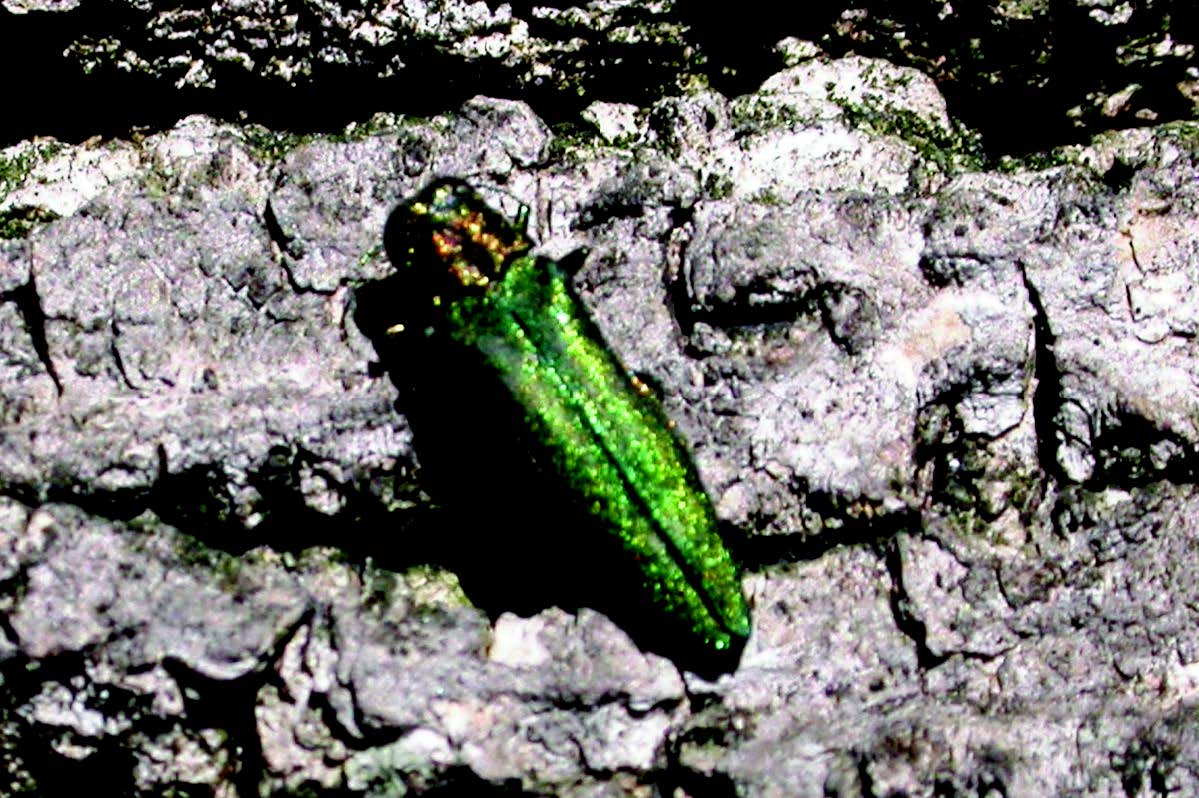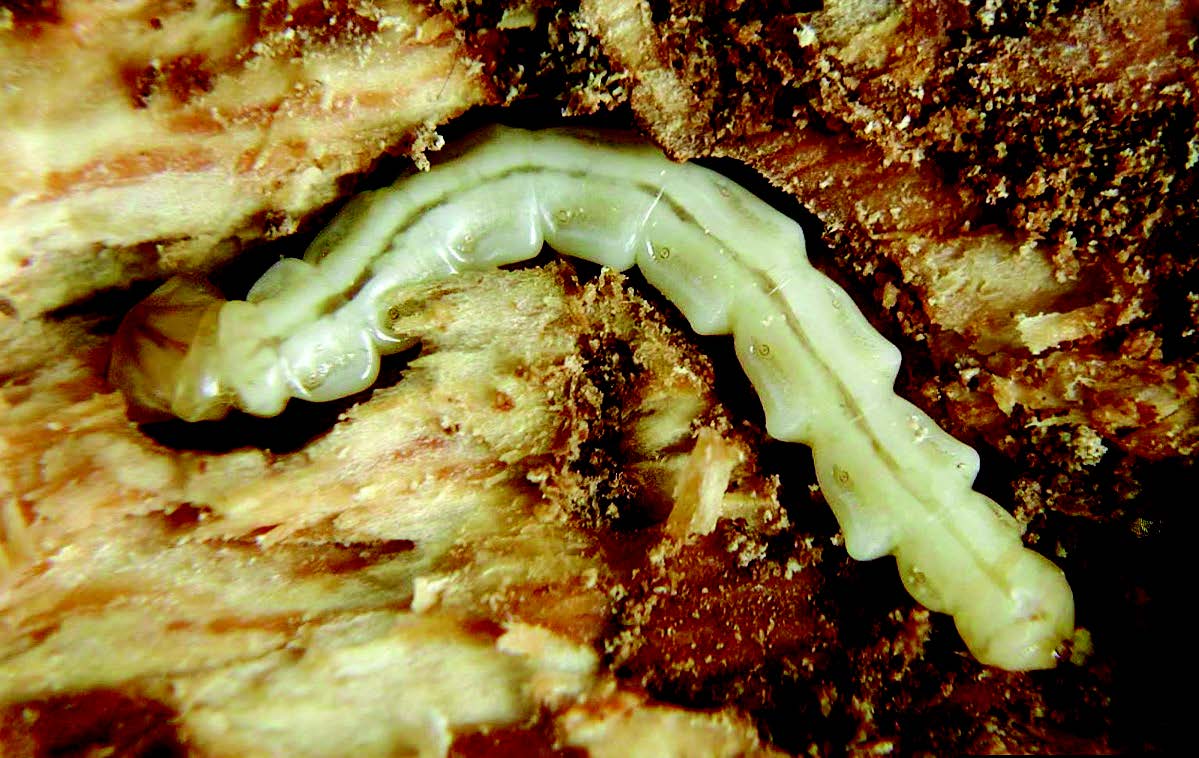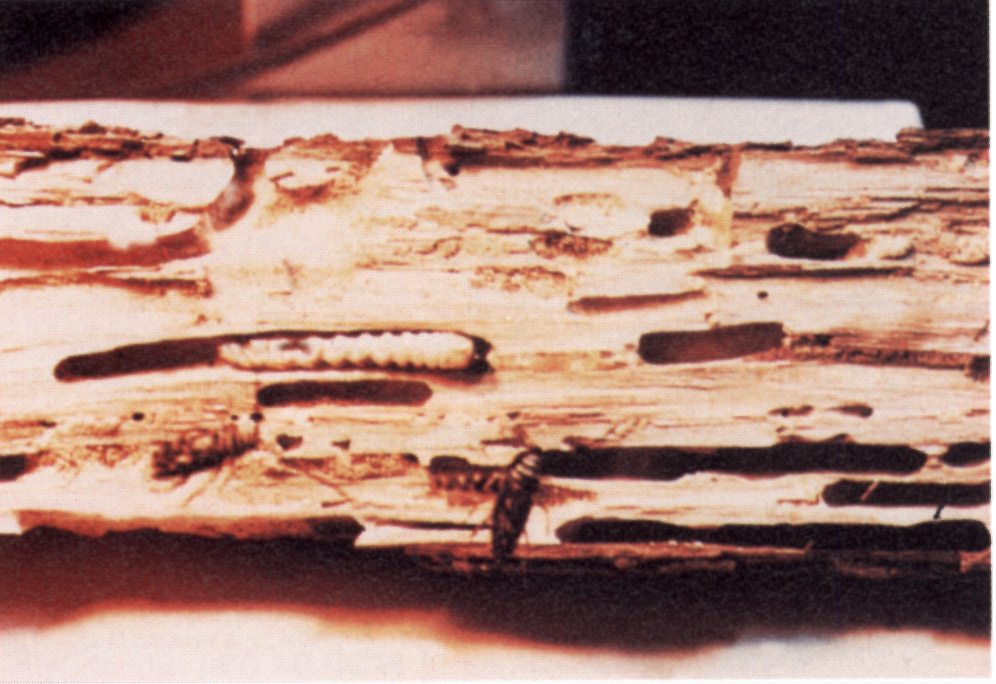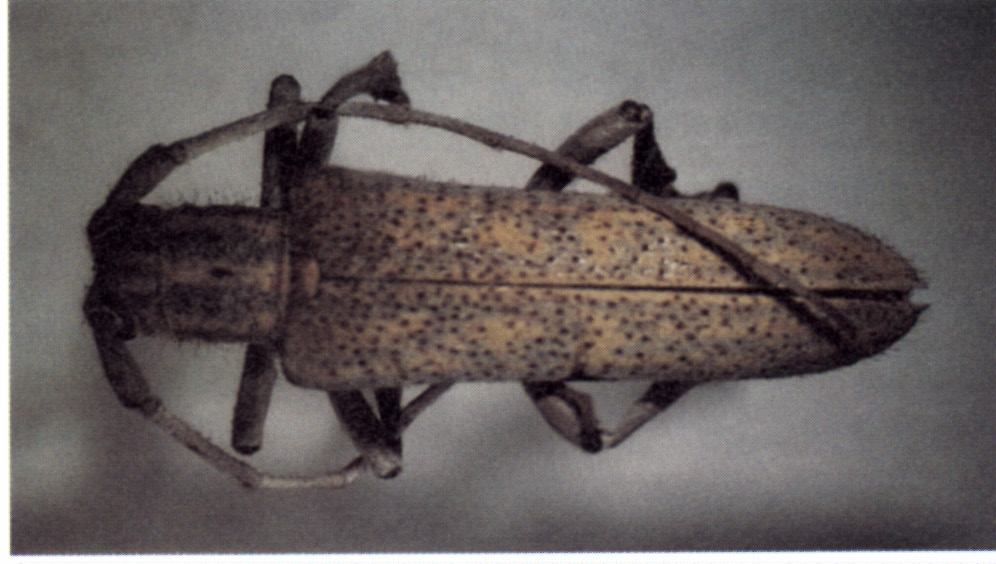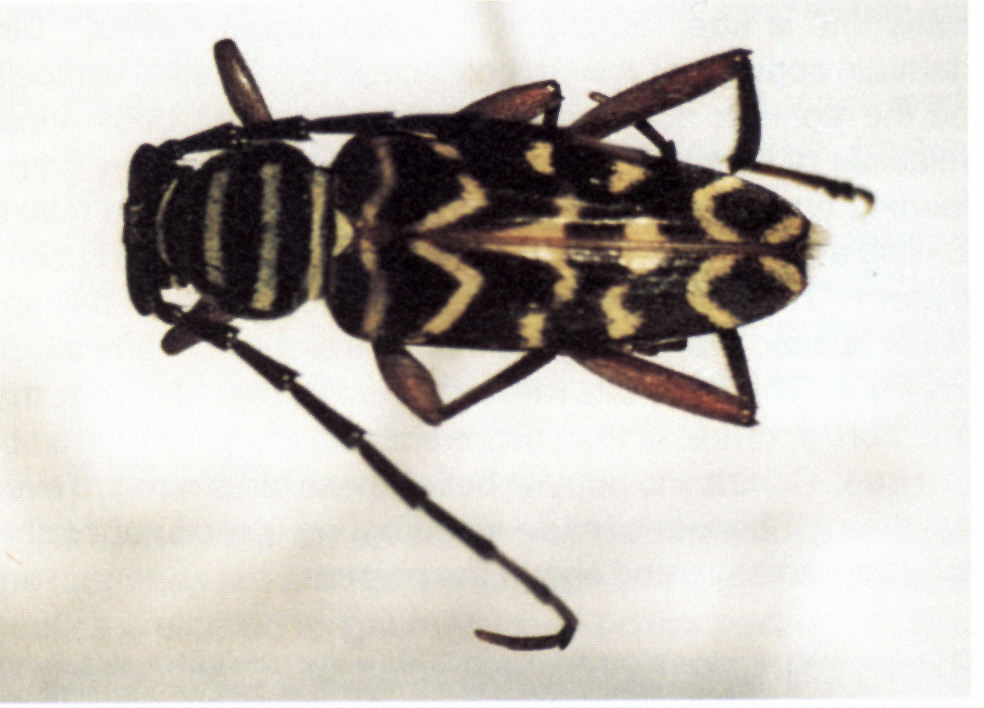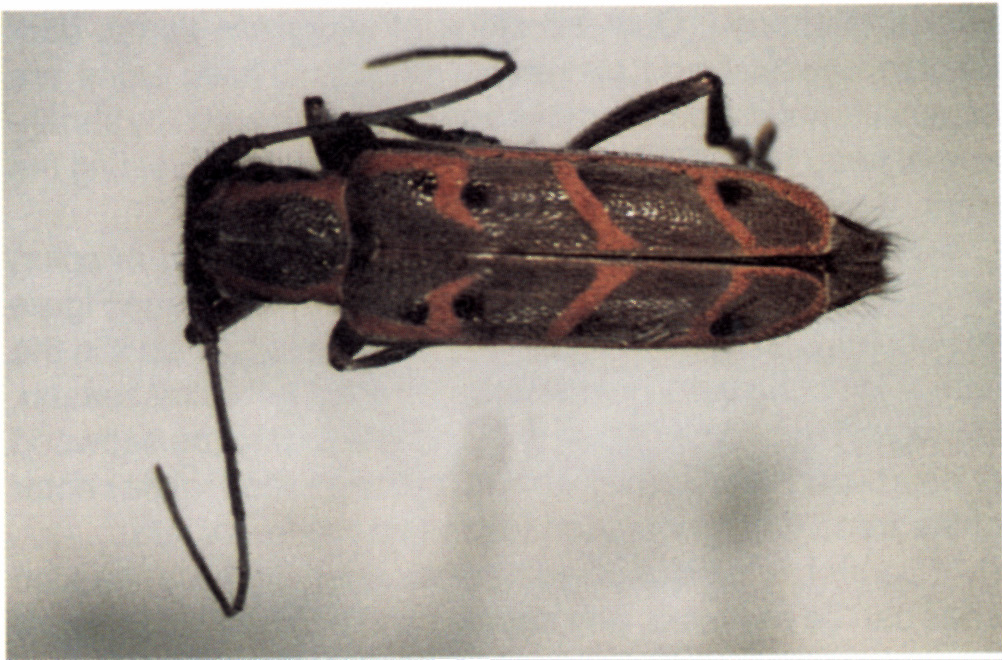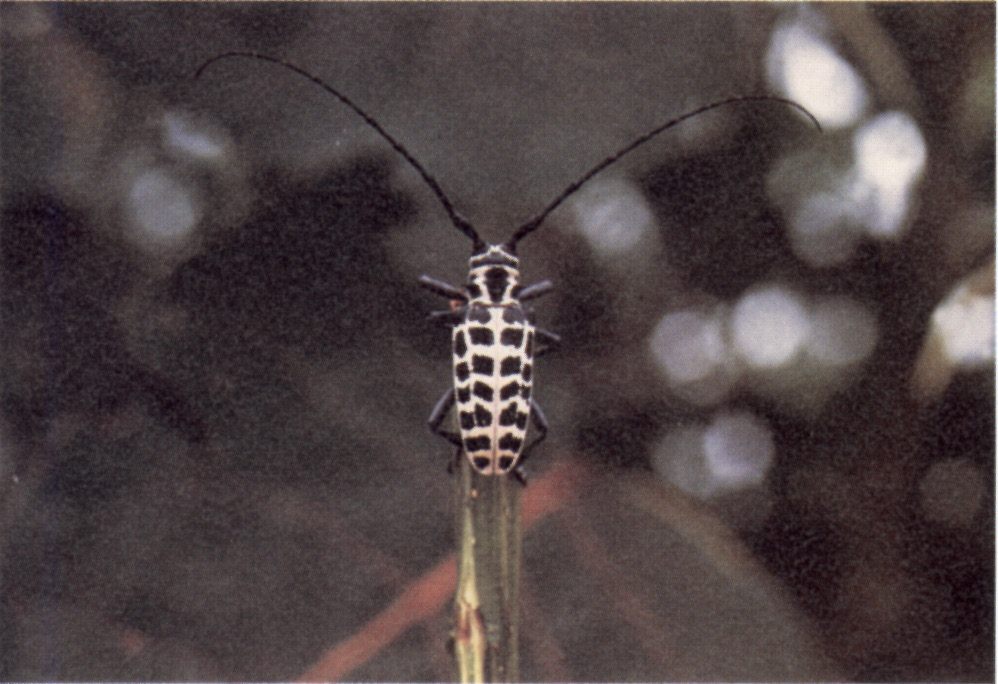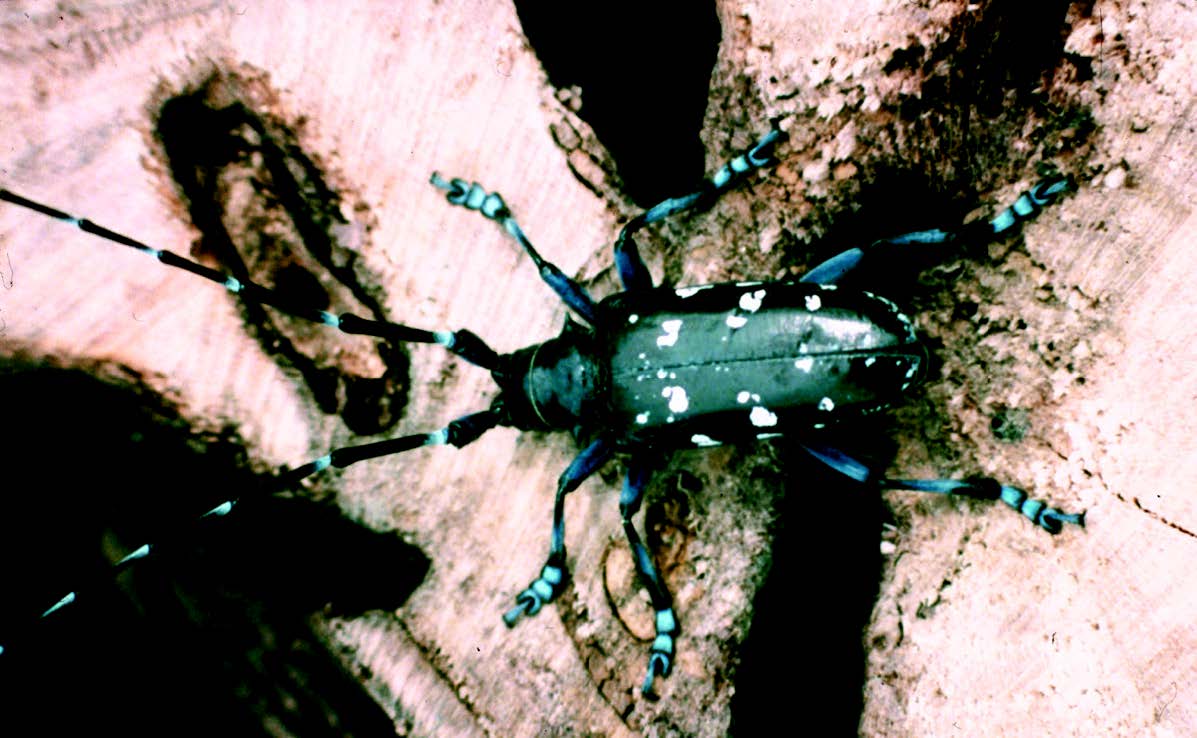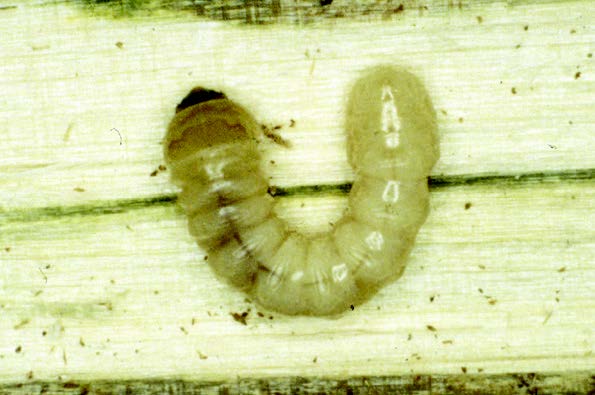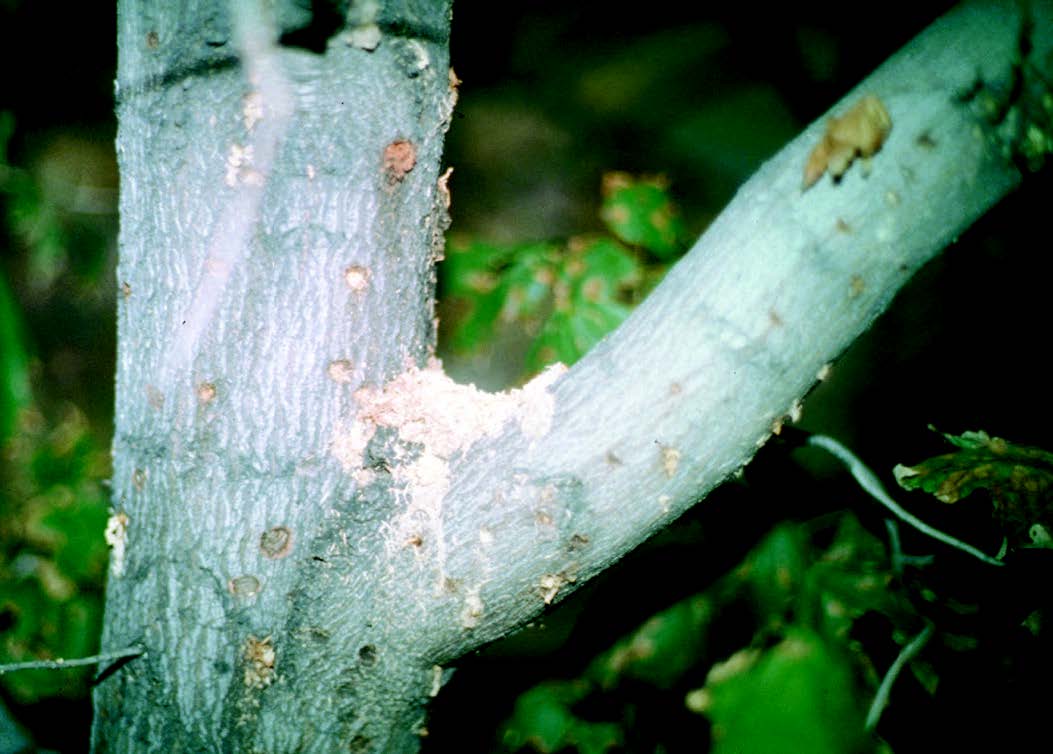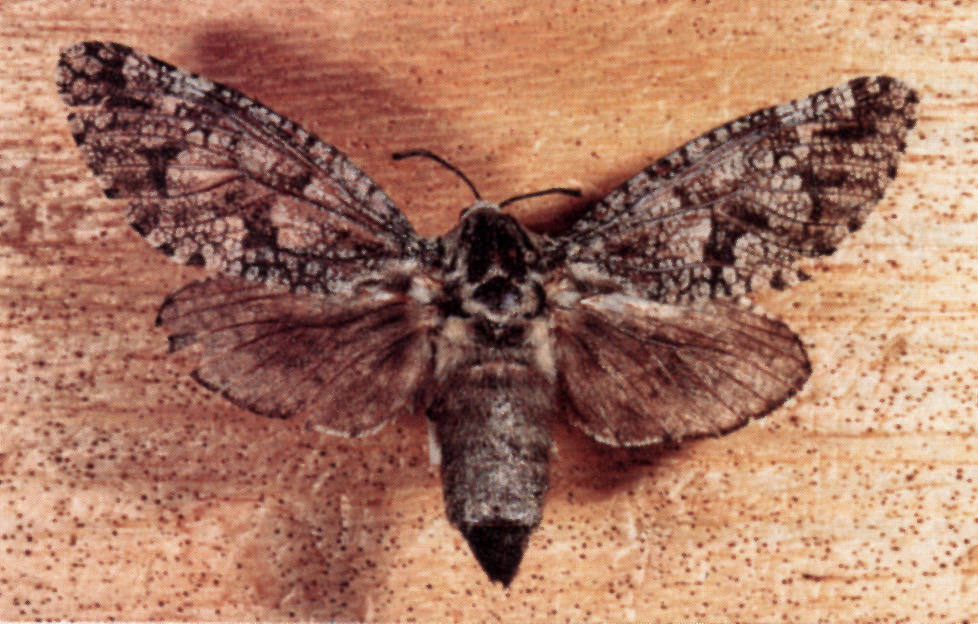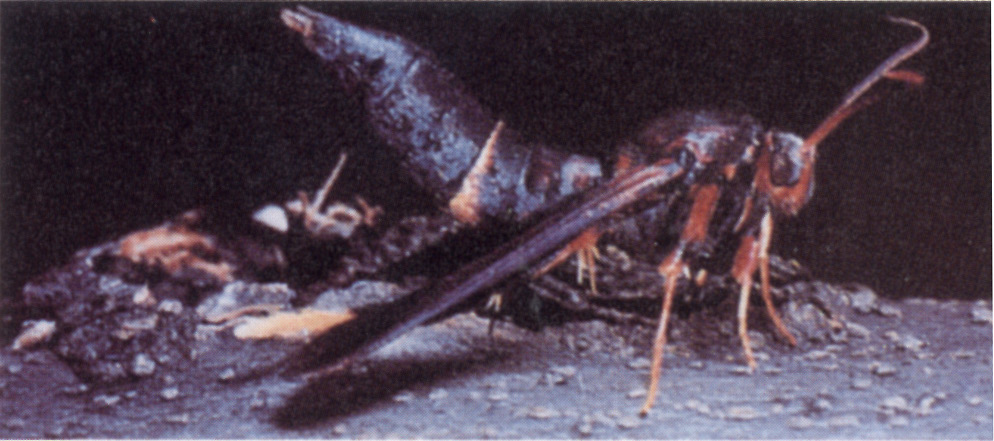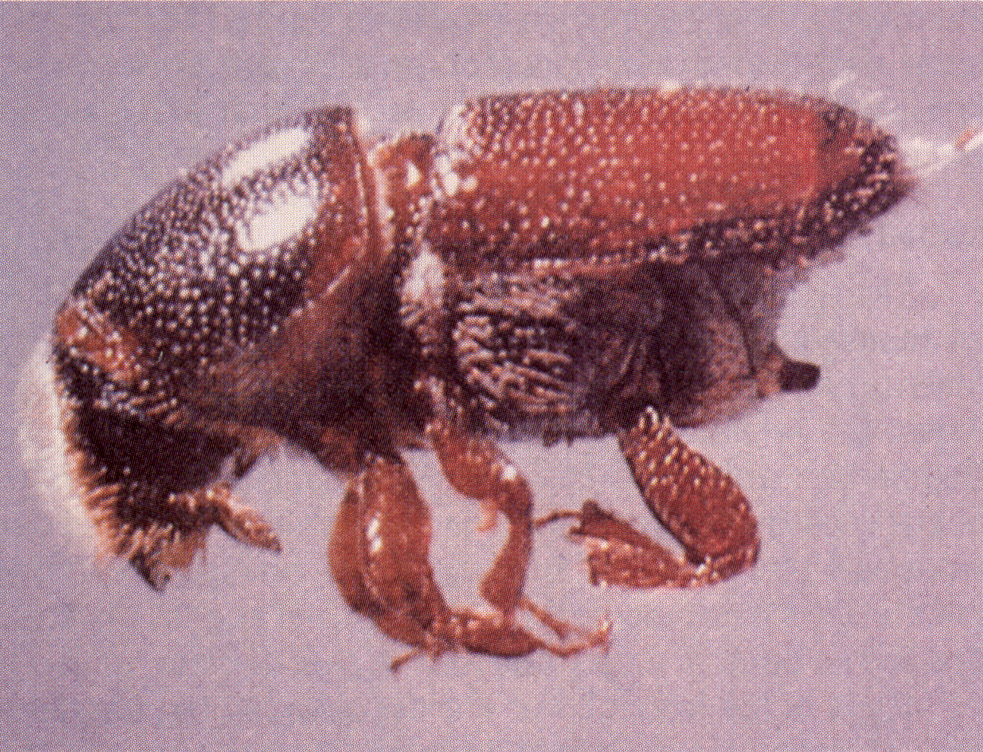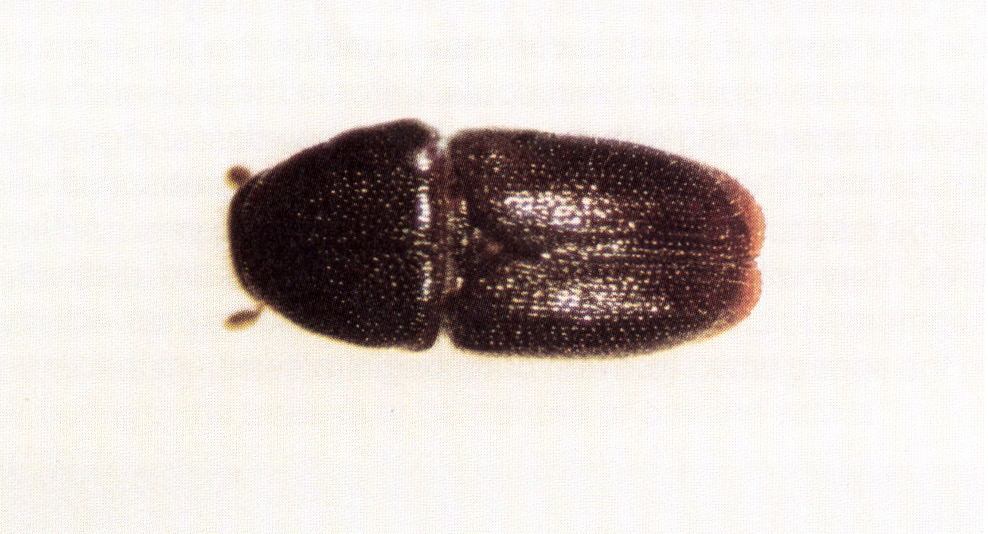Shade Tree Borers
Introduction
The term “borer” refers to the larval stage of some beetles and moths that feed inside the stems, branches, or trunks of plants, particularly woody plants. For example, roundheaded and flatheaded borers are the larvae of longhorned beetles and metallic wood-boring beetles, respectively. Lilac borers, peachtree borers, and the carpenterworm are caterpillars of wood-boring moths. Borers may feed in terminal shoots or burrow beneath the bark, or deep in the heartwood. A few insect borers will attack (and kill) healthy trees, but most occur in trees that are stressed or weakened from transplant shock, drought, defoliation, poor soil conditions, dirt fill over the roots, age, poor adaptation, or other causes. Nearly all shade trees are subject to borer attack, but life cycles and habits vary with each species of borer. Severe infestations can result in the decline and death of young trees. Generally, the presence of borers is indicated by their emergence holes through the bark that are often located at the base of the tree or in crevices in the bark. Other signs of a borer infestation include gummy exudation (ooze), dead areas in or under the bark, or small piles of sawdust or wood cuttings. Borers that feed under the bark frequently girdle the trunk, which can eventually kill the tree. Those that tunnel in the heartwood increase the tree’s vulnerability to wood-rotting organisms and wind damage. Trees are most susceptible to attack during the first year after transplanting, during an extended drought, or if disturbed by construction. Once borers enter the cambium, sapwood, or heartwood they are protected from most control efforts. Their presence may remain concealed until it is too late to save trees. Some suggested borer management tactics listed in this publication apply universally to all plants and species of boring insects. Others are very specific. Vigorously growing trees are not especially attractive to borer attack, so practices that encourage rapid establishment and healthy growth will discourage borer infestations. Effective practices to prevent borer infestations include:
- Protect trunks of young or transplanted trees with nursery wrapping paper, burlap, aluminum foil, or newspaper to prevent egg laying. Spray trunks with a properly labeled insecticide before wrapping, and then wrap the tree during fall leaf drop. Keep the wrap on until full leaf expansion in the spring, then remove, spray and rewrap the following fall. Another option is to simply leave the trunk “twiggy” for two to four years (if there are lots of small twiggy branches on the trunk). Do not let ties bind the trunk.
- Stimulate vigorous growth with proper fertilization and watering (refer to OSU Extension Fact Sheet HLA-6412, Fertilizing Shade and Ornamental Trees).
- Prune out all dead and dying branches (refer to OSU Extension Fact Sheet HLA-6409, Pruning Ornamental Trees and Shrubs).
- Select trees and shrubs that are locally adapted and preferably are less susceptible to borer attack. Ash, birch, cottonwood, locust, soft maple, flowering stone fruits (e.g. peaches and plums), willow, and poplar are especially susceptible to borers.
In Oklahoma, the predominant shade tree borers include roundheaded and flatheaded borers. Adult roundheaded beetles are called longhorned beetles because of their long antennae. Adult flatheaded beetles are called metallic wood-borers because of their iridescent, metallic luster.
Flatheaded Borers
Adult flatheaded borers are boat shaped, generally metallic and colorful beetles that range from 1/3 to 1 inch in length. The larvae, or grubs, are 1/4 to 2 inches long, yellowish-white, and legless with a pronounced flattened enlargement of the body just behind the head. This enlargement bears a hard plate on both the upper and lower sides (see Figure 1). Flatheaded borers are especially injurious to established or mature shade and ornamental trees. They typically attack the sunny side of the tree (south and west). As they feed, they produce a shallow, long winding, oval gallery beneath the bark. They can sometimes damage or kill a tree by effectively girdling it, or tunneling into sapwood and heartwood. The life cycle of most flatheaded borers usually take one or two years, but some species have been known to take 25 or more years.
Figure 1. Flatheaded wood borer larva.
Flatheaded Appletree Borer
This borer larva causes substantial damage to ornamental plantings, nursery stock, and a wide variety of fruit and shade trees across Oklahoma. Each year it kills scores of recently-transplanted shade, pecan, and fruit trees. Furthermore, it sometimes attacks and kills large, well-established trees if they are growing under drought or unfavorable environmental conditions. The adult beetle is boat shaped, dark greenish-bronze, and iridescent (Figure 2) and measures 1/2 inch. Adult beetles are active throughout the summer. They lay eggs in cracks in the bark or under loose scales, producing one full generation per year. Adult beetles chew directly through the bark to emerge, and feed on tender bark in crotches or around bud scars of trees. Eggs hatch about a week after being laid. The tiny borer enters the tree by chewing through the part of the egg that is in contact with the wood. Newly hatched larvae feed on living tissue in and surrounding the cambium layer until fully developed. The full-grown whitish-yellow larva is somewhat flattened, with a large swollen segment just behind the head which is partly retracted into the first body segment. It ranges from 1/2 to 1 inch in length. When full grown, the borer larva cuts deep into the sapwood and heartwood, turns its tunnel at right angles either upwards or downwards, and forms a cell in preparation for overwintering. In the spring, the larvae pupate without further feeding. They emerge as adults beginning in early May, continuing through July. Adult beetles are present on trees from early May to September or later depending upon the weather. Infested trees look unthrifty because borer infestations can produce scant foliage, dead branches, and dead areas in the bark of the main trunk or larger branches. Infestations are most common on the south and west sides of the trunk. Signs of infestation include: small oval holes where beetles have emerged; scars where heartwood or sapwood is showing, the bark growing over part of the dead area, or loosened bark. Larvae create irregular, winding tunnels underneath the bark of the host tree that are packed full of sawdust. The larval borers will be found feeding in the tunnels during the growing season. Newly transplanted or young trees are often girdled and killed and larger trees seriously injured due to the loss of large patches of bark over the mined areas. Flatheaded appletree borer infestations can be minimized by maintaining tree vigor, wrapping trunks of new transplants with high grade wrapping paper or burlap, and shading the south side of newly planted trees. Dead branches and trees, particularly those that have been dead for one to two years, should be removed before May 1 because they are sources of re-infestations from borers that have not yet emerged. Topping or dehorning trees always leaves dead wood that is an attractive breeding place for borers. Some relief can be realized by protecting weak and young trees by spraying trunks and larger limbs at about three week intervals during the early summer (see OSU Extension Fact Sheet EPP-7306, Ornamental and Lawn Pest Control for chemical suggestions).
Figure 2. Adult flatheaded appletree borer.
Emerald Ash Borer
The emerald ash borer, while not currently established in Oklahoma, is a serious threat to one of our most common shade trees. If found, its presence should be reported immediately to the Plant Industry and Consumer Services Division of the Oklahoma Department of Agriculture, Food and Forestry — (405) 521-3864. The emerald ash borer is an exotic beetle native to China that was first reported attacking ash trees in Michigan and Windsor, Canada in July 2002. It has since been found in 13 counties in Michigan, five counties in Ohio, and some infested nursery stock was sent to Maryland. The adult beetle is about 1/2 inch, slender, with a brassy, golden-green colored body, and bright metallic, emerald green wing covers (Figure 3). Larvae have 10 cream-colored, flattened, readily apparent body segments and reach 1/2 inch in length (Figure 4). They have a brown head capsule that is mostly retracted into the first fleshy segment behind the head. This insect has a one-year lifecycle. It will attack healthy, actively growing ash trees, and kill them. The larvae can live on trees two inches (or smaller) in diameter. The adult beetle leaves a “D” shaped exit hole about 1/8 inch in diameter. Larvae produce winding galleries under the bark that are packed with a fine frass. While an infested tree will eventually die, it may be infested for two to three years before showing obvious symptoms.
Figure 3. Emerald ash borer adult. (Ed Czerwinski, Ontario Ministry of Natural Resources. Image 1439005. www.insectimages.org)
Figure 4. Emerald ash borer larva. (David Cappaert, Michigan State University. Image 1460071. www.insectimages.org)
Roundheaded Borers
Adult roundheaded borers (also known as longhorned beetles) range from less than 1/4 inch to over 3 inches long. They are cylindrical or straight sided, hard-shelled beetles, frequently beautifully banded, spotted, or striped with contrasting colors. The larvae are white to yellowish, rather round-bodied grubs with a circular enlargement behind the head and a hard plate on the upper side. Most have small legs, but some are legless. Larvae feed beneath the bark before entering the wood, while others never bore into the wood. Larval tunnels are packed with borings arranged in concentric layers so that arc-like bands appear when galleries are exposed. Borers commonly burrow in the heartwood; tunneling holes as large as or larger than a pencil (see Figure 5). Larvae produce a coarse, sawdust-like frass which is often observed around the base of the tree. Generally, roundheaded borers are more numerous and more destructive than flatheaded borers. Some important members of this destructive group are the red headed ash borer, cottonwood borer, locust borer, elm borer, poplar borer, and painted hickory borer. The poplar borer and painted hickory borer are shown in Figure 6.
Figure 5. Roundheaded wood borer larva and tunnels.
Locust Borer
The locust borer is a very destructive pest of black locust. The adult locust borer is a jet black beetle with bright yellow markings on the wing covers (elytra) and measures about 3/4 of an inch (see Figure 7). Adults are quite numerous in late summer through September and frequently feed on flowers of goldenrods during morning hours. Later in the day, sometimes well after sunset, they can be seen running up and down the trunks of black locust trees in search of egg laying sites. Eggs are deposited in cracks in the bark of trees. Newly hatched borers (larvae) bore into the inner bark and construct small overwintering cells in the inner bark just beneath the outer corky layer. The whitish, cylindrical larvae have distinct body segments and don’t mature until mid-summer of the following year, reaching 3/4 to 1 inch long. Overwintering larvae resume feeding in the spring when tree leaf buds begin to swell, boring into the wood to feed until maturity. The entire life cycle requires about one year. One of the first signs of locust borer attack may be the presence of brownish sawdust and wet spots (late summer). Later in the season these spots become filled with a wet, yellowish sawdust and gummy exudation. Stressed trees and young trees less than 7 inches in diameter are more likely to be attacked. In areas where this borer is a problem, black locust should not be planted as a shade tree. When planted in wood lots, stands should be mixed with other species. Old trees that have been topped should be removed because they can become a source for continued infestations. Locust groves should not be grazed, because grazing stresses the shallow-rooted trees, which in turn becomes a more attractive target for the beetle. Some protection may be obtained by thoroughly spraying tree trunks with a registered insecticide from late August through the end of September, which kills adults as they laying eggs.
Figure 6. Adult poplar borer (top) and painted hickory borer (bottom).
Figure 7. Adult locust borer.
Elm Borer
The elm borer attacks American and slippery elms. The adult measures 3/8 to 1/2 inch with a grayish or fawn colored body that has three orange-red transverse lines across each wing cover and twin black spots on the thorax (Figure 8). Full grown larvae measures 1/2 inch. Elm borers are more common in cities where shade trees are growing under adverse conditions. Adults are present on trees from late April through late July and complete a full life cycle in one year. Eggs are deposited in small holes chewed in bark crevices, usually on freshly cut logs or weakened trees. The larvae bore beneath the bark, filling the mines with fibrous frass and completely destroying the phloem and cambium. When they reach maturity, they bore into the wood and construct cells where pupation occurs. Affected trees tend to die very slowly, a branch at a time. Presence of the elm borer is first indicated by thinning of foliage and dead limbs scattered around the tree and sawdust in crevices in the bark. Infested branches and trees should be removed and burned before May 1. Remember, dehorning and other poor pruning practices encourages borers (see OSU Extension Fact Sheet HLA-6409, Pruning Ornamental Trees and Shrubs for pruning suggestions).
Figure 8. Adult elm borer.
Cottonwood Borer
Adult cottonwood borers are conspicuously colored black and white longhorned beetles that measure 1 1/4 to 1 1/2 inches in length (see Figure 9). The larva is a large white deeply segmented grub that reaches 1 3/4 to 2 inches long when fully grown. The cottonwood borer attacks cottonwood, poplar, and willow trees. They attack the tree mostly at or below ground level and may completely girdle the trunk. Adult beetles may be found from late May through August. Eggs are deposited at or a little below ground level in a hole in the bark cut by the jaws of the female. Considerable injury may be done in this way to young cottonwood and willow trees. Upon hatching, the young borers work into the tender bark just outside the wood, penetrating into the wood at the approach of cold weather. The second winter, larger larvae occupy large tunnels at the base of the tree. Pupation occurs the second season. The entire life cycle extends for two-years. If ornamental plantings become infested, small larvae can be cut out from the base and/or inject a properly labeled insecticide or borer paste into burrow openings where fresh frass is noted.
Figure 9. Adult cottonwood borer.
Asian Longhorned Beetle
The Asian longhorned beetle, while not currently established in Oklahoma, is a serious threat to many of our most common shade trees. If found, it should be reported
immediately to the Plant Industry and Consumer Services Division of the Oklahoma Department of Agriculture, Food and Forestry — (405) 521-3864. This beetle is an exotic pest, native to China that was introduced into the U.S. through wooden pallets and packing material. It was first reported in 1996 infesting trees in Brooklyn NY, and in the Chicago area in 1998. The Asian longhorned beetle is a serious pest in China, and a potentially serious pest of trees in the U.S., particularly maples, birches elms, poplars, and willows. The adult beetle is about 3/4 to 1 1/4 inches, with a black body and mottled white spots on the back (Figure 10). Larvae are round, cream-colored, and 1 1/2 inches in length (Figure 11). Asian longhorned beetles will attack and kill healthy trees. This insect has a one-year lifecycle, with adults present from June through October. The adult beetle leaves a round exit hole about 1/2 inches in diameter with copious amounts of “sawdust” on the ground (Figure 12). Larvae produce winding galleries under the bark. While an infested tree will eventually die, it may be infested for two years before showing severe symptoms.
Figure 10. Asian longhorned beetle adult. (Kenneth R. Law. USDA APHIS PPQ Image 0949056. www.insectimages.org)
Figure 11. Asian longhorned beetle larva. (USDA APHIS Oxford, North Carolina Archives. Image 1148053. www.insectimages.org)
Figure 12. Asian longhorned beetle damage. (Robert A. Haack. USDA Forest Service. Image 3225081. www.insectimages.org)
Wood-Boring Caterpillars
Carpenterworm
The adult is a large moth, mottled gray in color, which appears in the late spring and early summer (Figure 14). The larva is a large, greenish-white caterpillar with a dark colored head that measures two to three inches long when mature (Figure 13). The carpenterworm makes large tunnels throughout the heartwood of oaks, elm, black locust, willows, ash, boxelder, poplar, cottonwood, and fruit trees such as pear and cherry. Outward signs of injury are damp, dark colored sawdust and excrement (frass). Frass may be especially noticeable in cracks and crevices as the dead bark shrinks. The dead bark may peel off, revealing the work of the younger larvae in the sapwood.The female moth deposits eggs in wounds or cracks in the bark. Larva hatch and begin to feed in the inner bark the first season. During the second summer, they tunnel into the sapwood or heartwood and feed in the heartwood to the center of the tree. One generation takes two to three years. Control is difficult in natural stands. Heavily infested trees can be removed, and stands can be thinned to promote more vigorous growth and resistance. Susceptible trees can be sprayed on the trunk and branches during warm days in the spring. Heavily infested trees should be removed and burned in the spring before moths emerge. The remaining stumps should be dug out and burned, since they may harbor borers below the soil line.
Figure 13. Carpenterworm larva.
Figure 14. Adult carpenterworm.
Lilac/Ash Borer
Adult lilac borers are clearwinged moths that resemble wasps (see Figure 15). Adults emerge in May from infested canes of lilacs or from privet, ash, and other closely related trees and shrubs. Females lay eggs on the lower portions of canes. Larvae (Figure 16) hatch and bore into stems causing leaves to yellow and wilt, and eventually will kill the canes. Frass produced by larvae is excreted from burrows. Winter is spent in the larval stage and there is one generation per year. A closely related species of ash borer emerges and lays eggs in the fall. Severely infested canes should be cut at soil level and destroyed in early spring. Noninfested canes can be treated with a registered insecticide starting in early May, repeating the application at two to three week intervals for two to three weeks.
Figure 15. Adult lilac borer.
Figure 16. Lilac borer larva.
Bark Beetles
Bark beetles, by definition, are wood borers because they feed between the bark and the wood. Adults are small brownish or blackish beetles. Larvae are white, curved, legless grubs with enlarged thoracic segments (Figure 17).Bark beetles usually attack dying or weakened trees. The adult tunnels through the bark and constructs an egg gallery where she lays eggs. The larvae create winding tunnels under the bark more or less at right angles to the egg gallery and pupate at the end of the feeding tunnel. Overwintering occurs under the bark, usually as larvae. There are usually two or three generations per year. OSU Extension Fact Sheet EPP-7164, Field Key to Beetles in Pines deals specifically with the major species of beetles found in pines in Oklahoma. Two of the most common species in Oklahoma are the smaller European elm bark beetle (SEEBB) (see Figure 18) and the shothole borer (see Figure 19). The SEEBB attacks all species of elms. They are the major carrier of Dutch elm disease, which attacks and kills American and other species of elm trees. Beetles emerge for an extended time and generations overlap, so adult beetles may be present continuously from early April through October. The shothole borer attacks fruit trees, wild cherry, wild plum, hawthorn, and elm. Usually, it is found in dead or dying limbs of older trees and is seldom the primary cause of death of a tree.
Figure 17. Bark beetle larva.
Figure 18. Adult smaller European elm bark beetle.
Figure 19. Adult shothole borer.
Bird Damage
Sap suckers, a close relative of woodpeckers, cause damage to trees that is often attributed to wood boring insects. They visit a tree many times, feeding on sap accumulated in the holes they have drilled. Sap sucker damage appears as rows of holes circling or running vertically on the trunk or larger limbs of the tree. This contrasts with emergence holes of borers that occur in a random pattern on the trunk or in limbs of a tree. Contrary to popular belief, these birds rarely, if ever, dig through bark to capture wood-boring insects, but rather feed on cambium and sap in the phloem. The tree species most commonly attacked by sap suckers are pine, sugar maple, birch, willow, magnolia, apple, and pecan. In Oklahoma, the yellow-bellied sap sucker is the most common species that damages trees. They winter in the South and spend the summer in the northern part of the United States. Thus, they often cause damage during their migrations in the spring through early summer, and again in fall in Oklahoma.
Borers from Firewood
Occasionally borer adults emerge from infested firewood that is stored or brought indoors during the winter, causing concern to the homeowner. These insects entered the wood when it was a standing tree or when freshly cut and stored outdoors during the spring. When an infested piece of wood is brought inside, the warm room temperatures stimulate development and emergence of adults. Most of these insects are harmless because they attack only unseasoned wood. A common borer seen in Oklahoma is the redheaded ash borer (see Figure 20) that infests newly cut, or unseasoned ash, oak, hickory, persimmon, and hackberry. Thus, when infested firewood is stored inside for any length of time, ash borer adults may emerge. These pests are a nuisance, but will seldom, if ever, damage any structural timbers or household goods or re-infest wood inside the home. For specific information on chemical control of borers, refer to OSU Fact Sheet EPP-7306, Ornamental and Lawn Pest Control (For Homeowners).
Figure 20. Adult redheaded ash borer.

